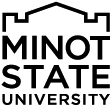Co-Curricular learning at Minot State University is ungraded learning that happens outside the classroom, which complements learning that happens inside the classroom. Within this learning structure, Minot State emphasizes four categories; Leadership, Wellness, Self-Awareness, and Career and Professional Development. For each category, a general goal, what a student should know and/or be able to do upon graduation, is specified. Additionally, each category has specific outcomes, connected to its co-curricular goal, stipulating what a student should know and/or be able to do as a result of what is learned in or through a specific activity or set of activities.
Co-Curricular Student Learning Goals and Outcomes- Defined as the relational process of influencing and guiding a group of individuals to achieve common goals
- Goal Statement: Minot State students will develop their leadership skills through individual, group, and community experiences.
- Key Components: Collaborators, problem solvers, innovators, change-makers
Outcome Statements:
- Students will guide others through processes involving collaboration, shared responsibilities, or teamwork.
- Students will apply problem-solving skills while working towards a common purpose.
- Students will use innovative approaches to solve problems.
- Students will affect positive change within their organizations.
- Defined as 8 dimensions of wellness (emotional, physical, occupational, intellectual, social, spiritual, environmental, and multicultural)
- Goal Statement: Minot State students will describe and apply the dimensions of holistic well-being.
- Key Components: Physical Dimension and Emotional Dimension
Outcome Statements:
- Students will develop emotional wellness-related knowledge, beliefs, and behaviors that promote individual and community well-being.
- Students will develop physical wellness-related knowledge, beliefs, and behaviors that promote individual and community well-being.
- Defined as the conscious knowledge of one’s own character, feelings, motivations, desires, strengths, and limitations
- Goal Statement: Minot State students will enhance their intrapersonal competence through their experiences.
- Key Components: Goal-directed behavior(self-management, self-motivation, self-monitoring, self-regulation a goal orientation, resilience, self-reflection), ownership(self-efficacy, growth mindset, confidence) (can, want, will), emotional and situational adaptivity(emotional intelligence, adaptability).
Outcome Statements:
- Students will reflect on their goal-directed behavior.
- Students will reflect on their self-efficacy, growth mindset, or confidence.
- Students will reflect on their emotional and situational adaptivity.
- Defined as skills and experiences that support students’ career/professional goals
- Goal Statement: Minot State students will develop the necessary life and professional skills to promote their future success.
- Key Components: Professional communication, time management, and professional demeanor
Outcome Statements:
- Students will develop appropriate communication for use in a professional setting.
- Students will use effective time management skills.
- Students will demonstrate appropriate demeanor in a professional setting.
- Purpose, Policy, and Procedure
- Assessment Calendar
- Assessment Training
- Yearly Program Assessment (YPA) Plans and Reports
» Co-Curricular Assessment Committee




